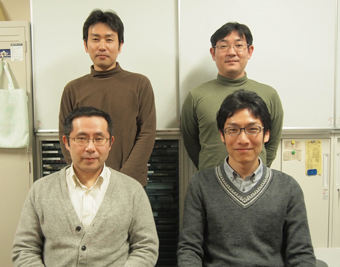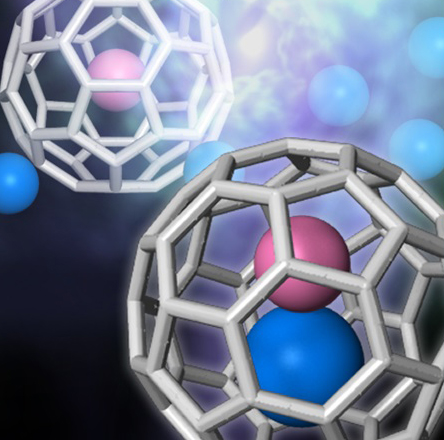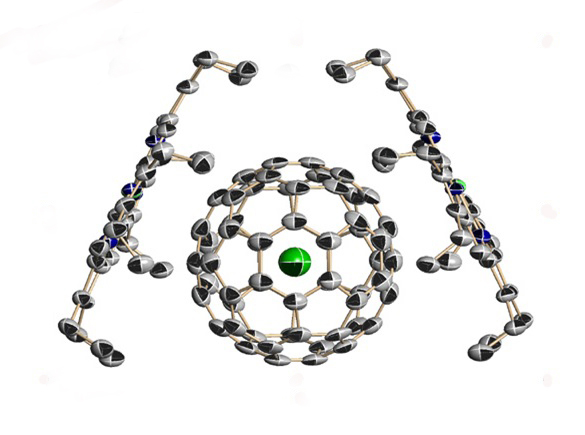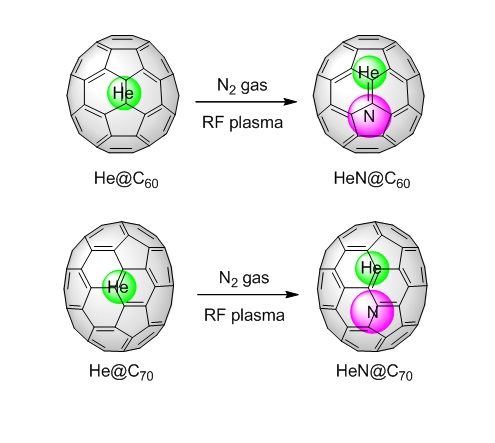Prof Murata, Y., et. al. “X-ray observation of a helium atom and placing a nitrogen atom inside He@C60 and He@C70” (Published in “Nature Communications” 5 March 2013)
|
X-ray observation of a helium atom and placing a nitrogen atom inside He@C60and He@C70
Published in “Nature Communications“(Online Publication, March 5, 2013).
Prof. Murata, Y., Assoc Prof. Wakamiya,A., Assist Prof. Murata, M., Mr. Morinaka, Y. (Structural Organic Chemistry, Division of Synthetic Chemistry) |

Prof. Murata, Y.(Front Left) Mr.Morinaka, Y.(Front Right) |
| Prof. Yasujiro Murata (Institute for Chemical Research, Kyoto Univeristy) and co-workers report the X-ray diffraction study of He@C60 and the clear observation of a single helium atom inside C60. In addition, the close packing of a helium atom and a nitrogen atom inside fullerenes is realized using two stepwise insertion techniques, that is, molecular surgery to synthesize the fullerenes encapsulating a helium atom, followed by nitrogen radio-frequency plasma methods to generate the fullerenes encapsulating both helium and nitrogen atoms. | |
|
Background Helium is well known as the smallest noble gas atom and it has refused to be directly observed by single crystal X-ray analysis, a powerful method to determine the molecular structure. This is because neither helium nor a helium-incorporating material becomes crystalline solid under atmospheric pressure even in the vicinity of 0 K. On the other hand, endohedral fullerenes are produced by simple application of “arc-discharge method”, “ion-implantaiton methods”, “high-temperature and high-pressure treatment”, and “molecular surgical method”. So far, the combination of these methods has not been reported. |
|
 |
|
|
Abstract They reported the single crystal X-ray observation of a helium atom inside C60 with the use of synchrotron X-ray. The relatively larger ellipsoid of the helium implied its translational motion at this temperature because there remains small space for the encapsulated helium atom inside C60. The present result clearly showed that a helium atom in C60 is observable by means of single crystal X-ray analyses. |
|

Figure 1.Single crystal X-ray structure of He@C60 sandwiched by two porphirin molecules |
|
|
In addition, the stepwise insertion of different atoms into fullerenes was achieved by the combined ‘molecular surgery’ and ‘nitrogen RF plasma’ methods. Even highly reactive nitrogen atom was found to coexist with a helium atom in a small space inside fullerenes. The ESR signals of the nitrogen atom were influenced by the helium coexisting in the same fullerene cages. Thus, these results are considered to be pieces of evidence for encapsulation of a nitrogen atom inside fullerenes. This technique is expected to create a variety of endohedral fullerenes, encapsulating heterogeneous atoms in the near future. |
|

Figure2. Generation of HeN@C60and HeN@C70 |
|
|
Future outlook The combination of ‘molecular surgery’ and ‘nitrogen RF plasma’ methods was found to be a new method to create yet-unknown endohedral fullerenes. This technique is expected to realize a variety of endohedral fullerenes encapsulating heterogeneous atoms in the near future, which would be promissing materials for organic photovoltaics and transistor as well as quantum computing. |
|
|
Acknowledgements This research was supported by the Grant-in-Aid for Scientific Research on Innovative Areas (No. 20108003, ‘pi-Space’) and Specially Promoted Research (No. 22000009) from MEXT and Collaborative Research Program of Institute for Chemical Research, Kyoto University (grant no. 2010-39). The experiment of synchrotron X-ray crystallography was performed at the BL38B1 in the SPring-8 with the approval of the Japan Synchrotron Radiation Research Institute (proposal number 2011A1409). |
|
| Related Links Kyoto University http://www.nature.com/ncomms/journal/v4/n3/full/ncomms2574.html |
|
 Institute for Chemical Research, Kyoto University
Institute for Chemical Research, Kyoto University International Joint Usage Research Center
International Joint Usage Research Center